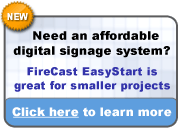It's no surprise that the debate over electronic billboards has moved to Detroit, the auto capital of the US. According to this article in the Detroit News, the usual arguments are being brought up by the usual suspects -- advertisers drooling over the prospect of serving up five or six ads in the space of one, and making changes instantaneously, governments and safety groups worrying about the impact on driver safety and decrying the additional visual clutter. In fact, the clip wouldn't be worth writing about except that I did learn this:
Detroit should brace for Las Vegas-style eyesores that could lead to traffic accidents, said Kevin Fry, president of Scenic America, a Washington-based opponent of the new signs.
"Your eye is drawn to these things every six seconds it's like a giant PowerPoint in the sky," he said. Fry said the billboards are likely to distract drivers from the road for more than two seconds -- the amount of time some studies have shown is dangerous for motorists to look at cell phones or iPods.
Ok, technically I learned two things. First, there's an anti-signage lobbying group called Scenic America, and second, billboards have to make their statement in less than two seconds. This short time frame is in keeping with P&G's study on the First Moment of Truth (FMOT), and also agrees with some of our own research on content use on digital signage (and specifically, retail media) networks.
My personal take on the situation is that in big cities, the march of roadside electronic billboards is unstoppable, though I can certainly see smaller municipalities banning them much as they've banned static roadside signage. Millions of drivers make their way down the Las Vegas strip or through Times Square without incident every year, and those areas are far more cluttered than the average road will ever be. So it seems like some amount of regulation (for things like brightness and animation, which certainly could cause accidents), and driver education/experience will probably make these devices no more dangerous than the typical static billboard.
Tags: electronic billboards, digital signage, out-of-home advertising


 Subscribe to this blog
Subscribe to this blog Follow Bill Gerba on Twitter
Follow Bill Gerba on Twitter
2 comments:
Yesterday, rolling through southern Georgia, we watched the price of Diesel fuel go from $2.779 to $2.819 .. in seconds. My wife was surprised that no one had to climb the 100+ foot sign to change it. Ten years ago, they did.
Truck stops along I-95 clearly live and die based on their signage. Most focus on fuel prices of course, but they also take advantage of crawling messages to highlight home cooking, chrome, and anything else of interest to a trucker, that can be expressed in just a few words.
Speaking of the crawl, I-95 message boards used to flash, fade, flicker, and basically try too hard. Guess what; nobody stops if they can't read the message, and there isn't time to resolve a lengthy message before you pass it. The crawl works, if you get the character timing right and the message is not too long.
A few days ago, somewhere in NJ, we saw a message on a large red LED board, where the first page of text appeared and then exploded, and the second page ... was moot, because we went by as the explosion graphics settled down, and didn't have time to read the second half of the message. Complete waste of time and money.
A more successful display on a similar board in eastern PA presented at least five, two or three line messages in sequence. One of them convinced us to buy Pepsi at that Walgreens. There was time to comprehend all the messages because the board was placed near a busy intersection with very long red lights, not alongside or above an interstate.
We have one of those large, full color graphic display billboards in Fort Lauderdale. The graphics are mostly too busy, too coarse, and too fast- changing to comprehend unless you're stuck in traffic. At night, the damn thing is so bright that you have to look away or lose your night vision. Another complete waste of time and money.
When the price of those large digital billboards comes down from the stratosphere, truck stop operators will probably embrace them, and I expect they'll quickly learn to use them effectively ... which is very different from exercising every possible capability. Web page designers could take a lesson or six.
Hey Mike,
Great update from "the field" :) Clear Channel and Lamar are both doing some pretty interesting things with roadside electronic billboards right now, but I tend to agree -- there's too much flashy eye candy, and too little content that effectively communicates a message. Most are still better served with static vinyl signage.
But I'm sure that will change as content creators master the peculiarities of this new medium. And given how the big guys are salivating over the prospect of selling the same "space" 6 or 8 times a month by offering rotating spots on an electronic sign, they're not about to go away any time soon, even with very high initial capital costs.
Post a Comment